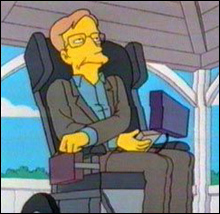 Stephen Hawking is possibly the greatest physicist of the last century, and arguably one of the most influential ever. His list of achievements is enviable, and what makes them even more astounding is that many of his accomplishments have been achieved whilst he has suffered from a debilitating form of motor neuron disease. Amyotrophic Lateral Sclerosis (ALS) is a progressive and ultimately fatal neuromuscular disease, but despite enduring this difficulty, he has 184 scientific publications, including a best selling book A brief history of time. This week, we are going to look not at this man’s scientific achievements, but at some of the cool technologies he uses to communicate.
Stephen Hawking is possibly the greatest physicist of the last century, and arguably one of the most influential ever. His list of achievements is enviable, and what makes them even more astounding is that many of his accomplishments have been achieved whilst he has suffered from a debilitating form of motor neuron disease. Amyotrophic Lateral Sclerosis (ALS) is a progressive and ultimately fatal neuromuscular disease, but despite enduring this difficulty, he has 184 scientific publications, including a best selling book A brief history of time. This week, we are going to look not at this man’s scientific achievements, but at some of the cool technologies he uses to communicate.Most people have heard Hawking’s distinctive computerised voice – he lost the ability to talk when he was forced to have a tracheostomy in 1985 following severe pneumonia. He communicates using a computer system with batteries based under his wheelchair, as because he is quite a busy man and always moving from place to place, it cannot be powered by direct connection to mains power. His computer can also be powered directly off his wheelchair motor battery.
The screen is mounted on the arm of the wheelchair and is powered by a Centrino Pentium M 1.5GHz chip. The chair has an inbuilt wireless system that allows him to access the Internet throughout his home and office. In areas where wireless internet is not available, Intel manage a mobile phone account so that Hawking can dial in to the Cambridge server from anywhere in the world, via a Nokia laptop card phone.
Initially, Hawking spelled out words letter by letter by raising his eyebrows when someone pointed to the right letter on a spelling card. This was a pretty tedious task. These days however, Hawking uses a program called Equalizer, written by Words Plus Inc to write and talk. A cursor moves across the top of the screen, which can be stopped by Hawking by pressing a switch in his hand. Words are printed on the bottom part of the screen, and when the cursor moves to an appropriate point, Hawking can press the switch and choose a word – in this way he selects words and creates sentences. Using this method, he can communicate about 15 words a minute. The computer can also be directly connected to a telephone socket to make phone calls.
When his sentence is finalised, he sends it to a speech synthesizer built by Speech+, that creates the strange American accented computerised voice that we all know. He writes equations using a program called TEX, which translates his input into symbols, and prints them out. Using this technique, he also writes lectures, papers and books. Hawking can also operate his wheelchair by using an infrared ‘blink switch’ clipped onto his glasses. By scrunching up his right cheek, he is able to talk and compose his papers. That’s a very arduous task.
Recently, Hawking has upgraded his computer to Windows XP, which was difficult as Equalizer was written many years before for the DOS operating system. However, Intel funded the upgrade to XP and the rewriting of the whole Words-Plus program.
One of the other cool things that Hawking uses is a universally programmable infrared remote control connected directly to his computer system. This enables him to operate many of the electronic items in his home, such as televisions, DVD players and CD players. He can also open doors and operate lights throughout his house and workplace with the use of a radio-controlled device. Throughout the new Cambridge Centre for Mathematical Sciences, he will be able to get about the building virtually unaided.
However possibly the coolest thing Hawking has done is be on The Simpsons, not just once, but a number of times.
Check out Hawking’s homepage at www.hawking.org.uk for more information about his work and his disability.
Listen to this show here












I'm glad you found my iChair picture.
ReplyDeleteI enjoyed your podcast, and the update on Stephen Hawking. I've always been a huge fan of Hawking and his sense of humour, but I had no idea how he managed on a day to day basis at his home. His house sounds like it might rival that of Bill Gates in high-tech gagetry.
Hey jted,
ReplyDeleteGlad you like the podcast - your iChair pic is cool. It sums him up perfectly!
Cheers,
Marc
Send me the link of this Office Furniture OR chair book.
ReplyDeleteStephen Hawking's story is truly inspiring. His ability to overcome ALS and contribute immensely to physics is remarkable. It's fascinating to learn about the technology he uses to communicate, from the early spelling card to the advanced computer system. Speaking of communication, have you tried any of those fun io games online? It's amazing how accessible communication and entertainment have become, mirroring Hawking's journey to connect with the world.
ReplyDelete